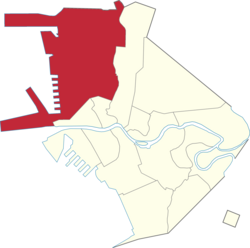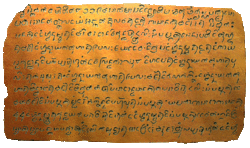Tondo, Manila
| Tondo | |
|---|---|
 Recto Avenue running through Divisoria. | |
 | |
| Country | Philippines |
| Region | National Capital Region |
| City | Manila |
| Congressional District | 1st and 2nd districts of Manila |
| Area | |
| • Total | 8.65 km2 (3.40 sq mi) |
| Population (2015)[1] | |
| • Total | 631,363 |
| • Density | 73,000/km2 (190,000/sq mi) |
| Time zone | UTC+08:00 (Philippine Standard Time) |
Tondo is a district located in Manila, Philippines. It is the largest in terms of area and population of Manila's sixteen districts,[2] with a Census-estimated 631,313 people in 2015 and consists of two congressional districts. It is also the most densely populated district in the city.
Contents
1 History
1.1 Etymology
1.2 Tondo in early Philippine history
1.3 Colonial Period
1.4 Contemporary period
2 Economy
3 Demographics
3.1 Crime
3.2 Culture
4 Education
5 References
6 Further reading
7 External links
History
Etymology
Numerous theories on the origin of the name "Tondo" have been put forward. Philippine National Artist Nick Joaquin suggested that it might be a reference to high ground ("tundok").[3] French linguist Jean-Paul Potet, however, has suggested that the River Mangrove, Aegiceras corniculatum, which at the time was called "tundok" ("tinduk-tindukan" today), is the most likely origin of the name.[4]
Tondo in early Philippine history

Laguna Copperplate Inscription (c. 900 AD)
The region of Tondo has been settled by humans for over 1,100 years. Historically, Tondo already existed in the year 900 AD according to the Laguna Copperplate Inscription,[5] a legal document written in Kawi now housed in the National Museum of Anthropology. According to this document, Tondo was ruled by person called Jayadeva who holds the Sanskrit title of senapati or the equivalent of an admiral. The Kingdom of Tondo also extended all the way to the modern-day province of Bulacan particularly around Lihan (Malolos) and Gatbuca (Calumpit).[citation needed]
Tondo was ruled by a line of lakan until the Spanish conquest.[citation needed]
Colonial Period
After the Spaniards conquered Tundun in January 1571 they established the Province of Tondo with the city of Manila as its center, the province covered much territories in Northern Luzon particularly Pampanga, Bulacan and Rizal (formerly called Morong)
In census conducted by Miguel de Loarca in 1583 Tondo was reported to have spoken the same language as the natives of the province of Pampanga.[6] Institute of National Language commissioner Jose Villa Panganiban also wrote that the dividing line between Kapampangan and Tagalog was the Pasig River, and that Tondo therefore originally spoke Kapampangan.[7] although Fray Isacio Rodriquez's Historia dela Provincia del Santisimo Nombre de Jesus de Filipinas stated that Provincia de Tagalos which is Tondo covers all the territories of the future Archdiocese of Manila.
Prior to the establishment of the Province of Bulacan in 1578 Malolos and Calumpit were also included in the territory of Tondo as its visitas. In 1800, the Province of Tondo was renamed to Province of Manila.[citation needed]
Tondo was one of the first provinces to declare rebellion against Spain in year 1896. In 1911, under the American colonial regime, there was a major reorganization of political divisions, and the province of Tondo was dissolved, and its towns given to the provinces of Rizal and Bulacan. Today, Tondo just exists as a district in the City of Manila.[citation needed]
Contemporary period
Slums developed in Tondo along the Pasig River. Authorities sought to improve housing conditions on these areas without condoning the action of squatting committed by the slums' residents. In the 1970s, the World Bank provided funds to improve conditions in Tondo which led the increase of rent prices and a property boom in the area. These caused the poor to be marginalized. The slums that were upgraded were legalized but these areas remain vastly different from other parts of Manila with higher population density, more irregular road and plot patterns, and uncontrolled housing.[8]
In the 1987 constitution, Tondo split into two congressional districts of Manila making the first district to the west while the second district in the east. Paco also split by fifth and sixth congressional districts which the fifth in the south and sixth in the north.
Economy

Manila North Harbor and slum settlements
Tondo hosts the Manila North Harbor Port, the northern half of the Port of Manila, the primary seaport serving Metro Manila and surrounding areas.[9]
The area also hosted Smokey Mountain, a landfill which served Metro Manila and employed thousands of people from around 1960 until its closure in the late 1990s. The dumpsite served as a symbol of poverty even at least two decades since its closure.[10]
Demographics

Busy street near Pritil Market
Due to urbanization as well as the Lina Law which favors squatters over land owners resulted to Tondo to being one of the most densely populated areas in the world at 69,000 inhabitants per square kilometer (180,000/sq mi).[11]
Crime
Tondo has developed a reputation for criminality and poverty. In 2010, Manila records state that Tondo has the highest criminal rate in the whole city with the most common crime being pick pocketing.[12]
Culture
The district celebrates the feast of the Santo Niño de Tondo annually on January which is dedicated to the image of the Santo Niño housed within the 16th century Augustinian Tondo Church. The Lakbayaw Street Dance Festival, a competition among Ati-Atihan groups and school, local and religious groups, served as the climax of the feast.[13]
Education
The Manila office of the Department of Education lists 26 public elementary schools and 11 public high schools in Tondo.[14]
References
^ "Highlights of the Philippine Population 2015 Census of Population". Philippine Statistics Authority. Retrieved July 11, 2017..mw-parser-output cite.citation{font-style:inherit}.mw-parser-output q{quotes:"""""""'""'"}.mw-parser-output code.cs1-code{color:inherit;background:inherit;border:inherit;padding:inherit}.mw-parser-output .cs1-lock-free a{background:url("//upload.wikimedia.org/wikipedia/commons/thumb/6/65/Lock-green.svg/9px-Lock-green.svg.png")no-repeat;background-position:right .1em center}.mw-parser-output .cs1-lock-limited a,.mw-parser-output .cs1-lock-registration a{background:url("//upload.wikimedia.org/wikipedia/commons/thumb/d/d6/Lock-gray-alt-2.svg/9px-Lock-gray-alt-2.svg.png")no-repeat;background-position:right .1em center}.mw-parser-output .cs1-lock-subscription a{background:url("//upload.wikimedia.org/wikipedia/commons/thumb/a/aa/Lock-red-alt-2.svg/9px-Lock-red-alt-2.svg.png")no-repeat;background-position:right .1em center}.mw-parser-output .cs1-subscription,.mw-parser-output .cs1-registration{color:#555}.mw-parser-output .cs1-subscription span,.mw-parser-output .cs1-registration span{border-bottom:1px dotted;cursor:help}.mw-parser-output .cs1-hidden-error{display:none;font-size:100%}.mw-parser-output .cs1-visible-error{font-size:100%}.mw-parser-output .cs1-subscription,.mw-parser-output .cs1-registration,.mw-parser-output .cs1-format{font-size:95%}.mw-parser-output .cs1-kern-left,.mw-parser-output .cs1-kern-wl-left{padding-left:0.2em}.mw-parser-output .cs1-kern-right,.mw-parser-output .cs1-kern-wl-right{padding-right:0.2em}
^ "Republic Act No. 409: AN ACT TO REVISE THE CHARTER OF THE CITY OF MANILA, AND FOR OTHER PURPOSES". Official Gazette. Retrieved 4 November 2017.
^ Joaqiun, Nick (1990). Manila, My Manila: A History for the Young. City of Manila: Anvil Publishing, Inc. ISBN 978-9715693134.
^ Potet, Jean-Paul G. (2013). Arabic and Persian Loanwords in Tagalog. p. 444. ISBN 9781291457261.
^ Paul Morrow's The Laguna Copperplate Inscription Archived 2008-02-05 at the Wayback Machine.
^ Miguel de Loarca's Census of 1583
^ Panganiban
^ "Settlements & Growth". Creating Neighbourhoods and Places in the Built Environment. Taylor & Francis. 2 September 2003. p. 39. ISBN 1135817901.
^ "SMC wrests control of port from Romero". Manila Standard. 18 February 2016. Retrieved 17 March 2018.
^ Endo, Jun (10 March 2017). "Mountain of garbage blights Manila". Nikkei Asian Review. Retrieved 17 March 2018.
^ "Tondo: The space in between". Al Jazeera. Retrieved 17 March 2018.
^ "Tondo has highest crime rate in Manila". ABS-CBN (in Filipino). 21 August 2010. Retrieved 17 March 2018.
^ Santos, Mat (20 January 2018). "Celebrating the Feast of the Sto. Niño". Manila Bulletin. Retrieved 17 March 2018.
^ "DepED Manila Public Schools". Department of Education Manila. Department of Education Manila. Retrieved 17 March 2018.
Further reading
- Gaspar de San Agustin, Conquistas de las Islas Filipinas 1565-1615, Translated by Luis Antonio Mañeru, 1st bilingual ed [Spanish and English], published by Pedro Galende, OSA: Intramuros, Manila, 1998
- Henson, Mariano A. 1965. The Province of Pampanga and Its Towns: A.D. 1300-1965. 4th ed. revised. Angeles City: By the author.
- Loarca, Miguel de. 1582. Relacion de las Yslas Filipinas. Blair and Robertson vol. 5 page 87:
- Panganiban, J.V. 1972. Diksyunaryo-Tesauro Pilipino-Ingles. Quezon City: Manlapaz Publishing Co.
- Mallat, Jean, Les Philippines: Histoire, Geographie, Moeurs, Agriculture, Idustrie, Commerce des colonies Espagnoles dans l'Océanie, Paris: Arthus Bertrand, Libraire de la Société de Géographie, 1846
- Santiago, Luciano P.R., The Houses of Lakandula, Matanda, and Soliman [1571-1898]: Genealogy and Group Identity, Philippine Quarterly of Culture and Society 18 [1990]
- Scott, William Henry, Barangay: Sixteenth-Century Philippine Culture and Society, Quezon City: Ateneo de Manila University Press, 1994
- Scott, William Henry, Prehispanic Source Materials for the Study of Philippine History, Quezon City: New Day Publishers, 1984
External links
 Media related to Tondo, Manila at Wikimedia Commons
Media related to Tondo, Manila at Wikimedia Commons
Coordinates: 14°37′01″N 120°58′01″E / 14.617°N 120.967°E / 14.617; 120.967
